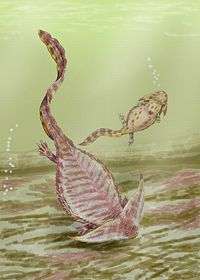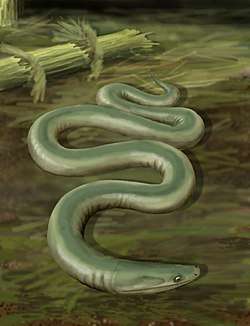Hapsidopareion
Hapsidopareion is an extinct genus of microsaur belonging to the family Hapsidopareiidae. Fossils have been found in the early Permian of Oklahoma.[1][2]
| Hapsidopareion | |
|---|---|
| Scientific classification | |
| Kingdom: | |
| Phylum: | |
| Class: | |
| Subclass: | |
| Order: | |
| Suborder: | |
| Family: | |
| Genus: | Hapsidopareion Daly, 1973 |
History of study
Hapsidopareion was named in 1973 by American paleontologist Eleanor Daly based on material collected from the early Permian South Grandfield locality in southwestern Oklahoma.[1] The genus name is given for the Greek hapsido- ('arch') and -pareion ('cheek'). The species name, H. lepton, is given for the slightness of the animal. The taxon is known from several partial to complete skulls and possibly by some isolated postcranial material.
Anatomy
Hapsidopareion was originally differentiated from other microsaurs by the large temporal emargination, which produced other variable morphology of the circum-emargination bones (e.g., postorbital). It is similar to the more recently described Llistrofus pricei in this regard, but can be differentiated from L. pricei by features such as the absence of a quadratojugal and a frontal excluded from the orbit.[3] Because all specimens of H. lepton are notably smaller than those of L. pricei, and a number of anatomical differences are likely ontogenetically variable (e.g., contact between neural arch and centrum), it has been considered that the former maybe represent a juvenile of the latter, but recent workers have maintained the separation of these taxa.[3][4]
Relationships
Hapsidopareion is the sister taxon to Llistrofus pricei. Collectively, this group forms the Hapsidopareiidae (traditionally called the 'Hapsidopareiontidae') and is recognized by the greatly enlarged temporal emargination.[4]
References
- Daly, Eleanor (1973). "A Lower Permian Vertebrate Fauna from Southern Oklahoma". Journal of Paleontology. 47 (3): 562–589. ISSN 0022-3360. JSTOR 1303204.
- Carroll, Robert L.; Gaskill, Pamela (1978). The order Microsauria. Philadelphia: American Philosophical Society. pp. 1–126. ISBN 978-0871691262. OCLC 4314948.
- Bolt, John R.; Rieppel, Olivier (2009). "The holotype skull of Llistrofus pricei Carroll and Gaskill, 1978 (Microsauria: Hapsidopareiontidae)". Journal of Paleontology. 83 (3): 471–483. doi:10.1666/08-076.1. ISSN 0022-3360.
- Gee, Bryan M.; Bevitt, Joseph J.; Garbe, Ulf; Reisz, Robert R. (2019-01-25). "New material of the 'microsaur' Llistrofus from the cave deposits of Richards Spur, Oklahoma and the paleoecology of the Hapsidopareiidae". PeerJ. 7: e6327. doi:10.7717/peerj.6327. ISSN 2167-8359. PMC 6348957. PMID 30701139.
See also
- Prehistoric amphibian
- List of prehistoric amphibians




